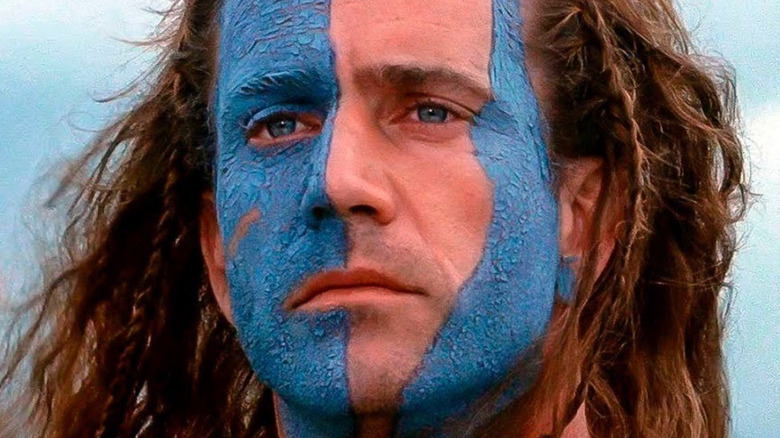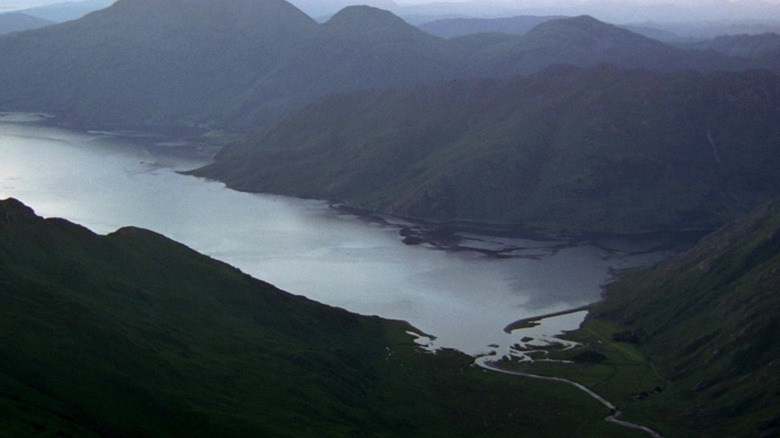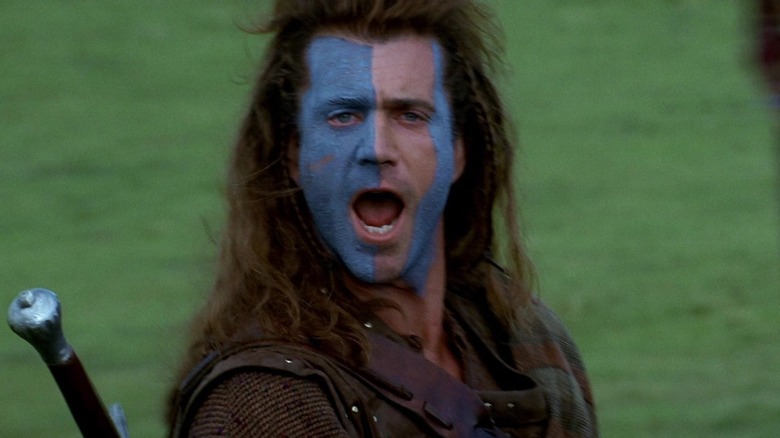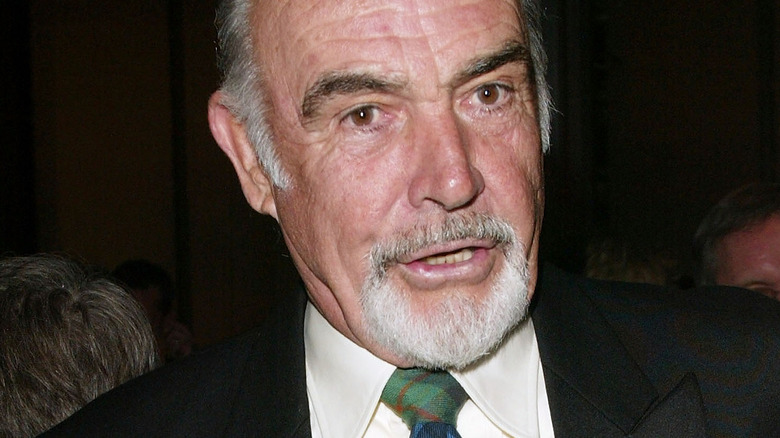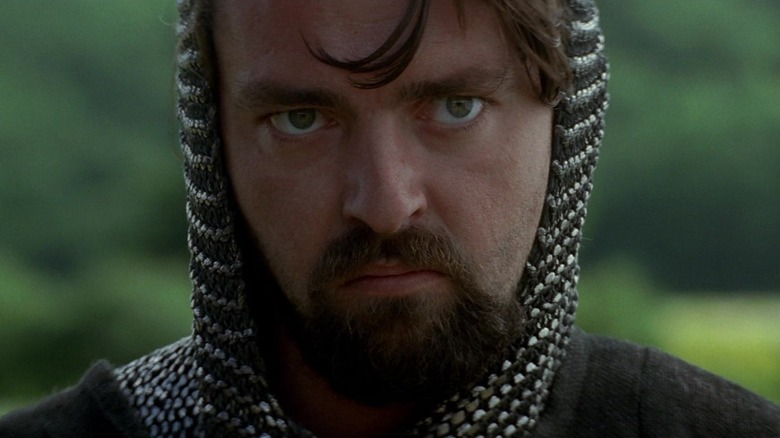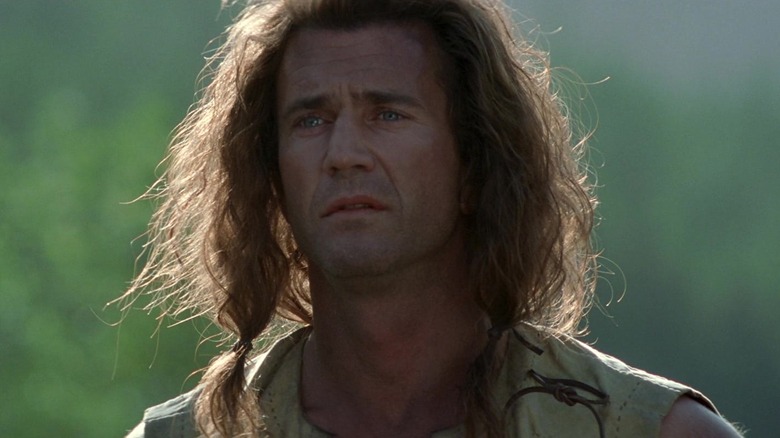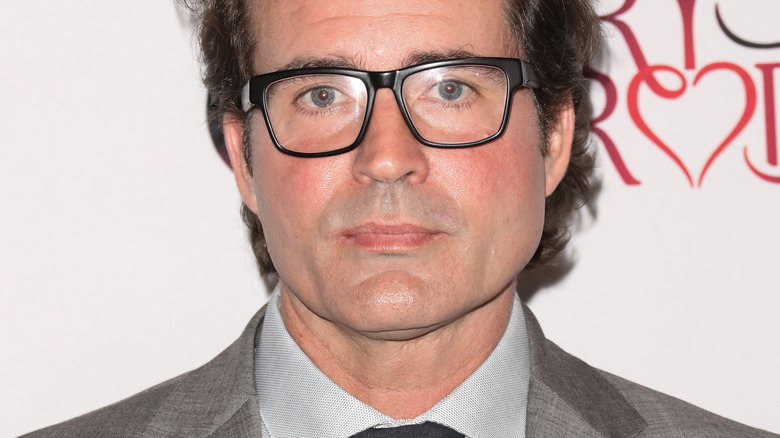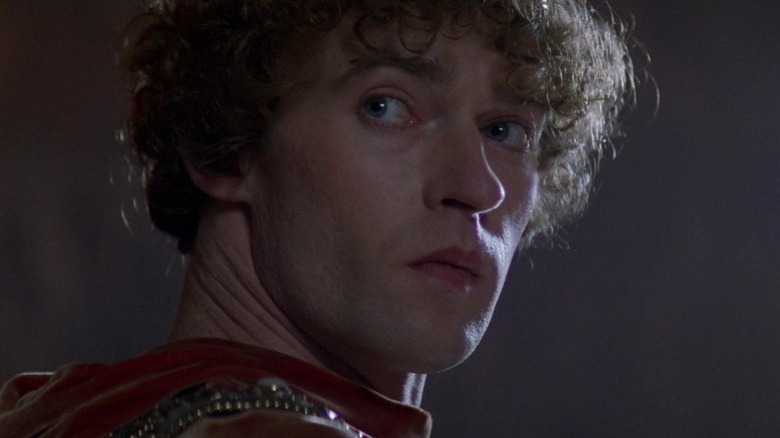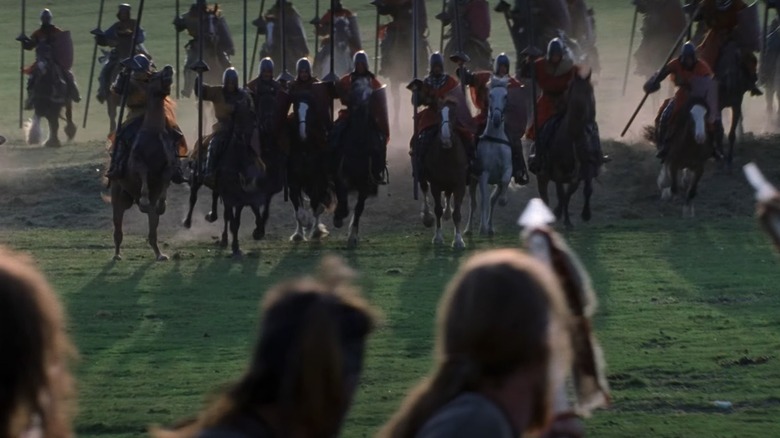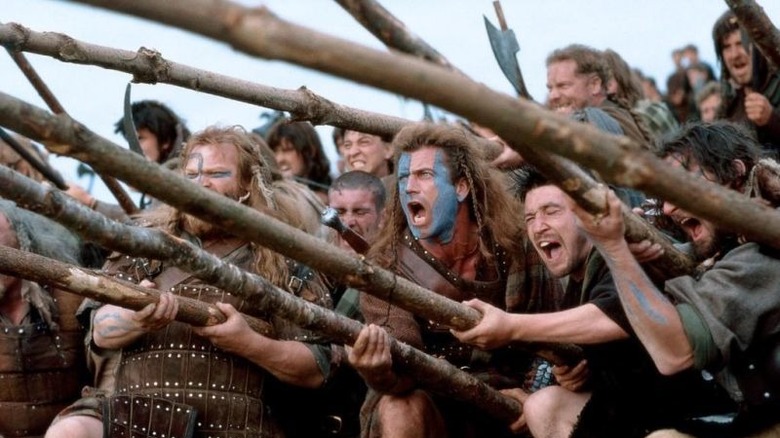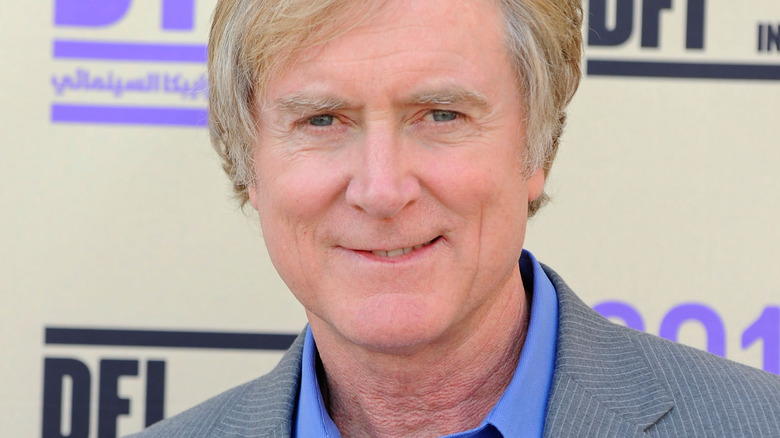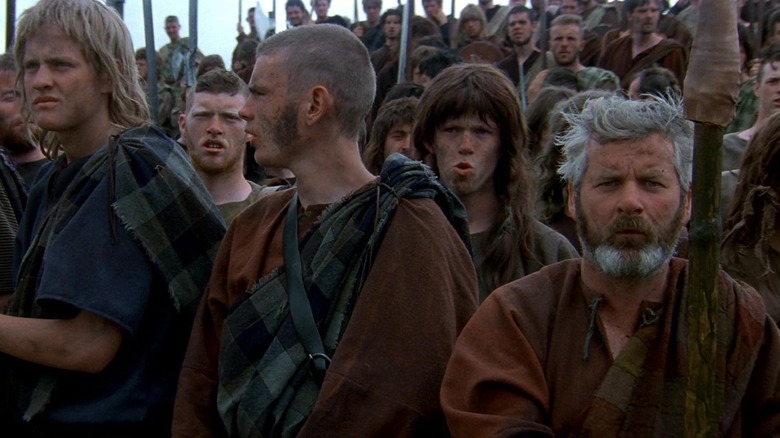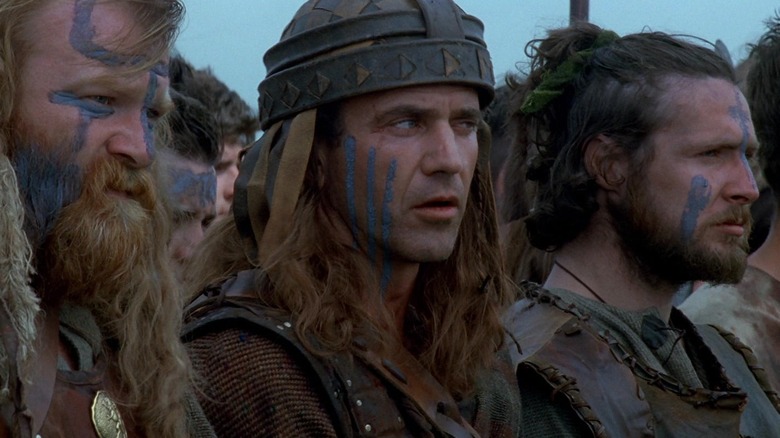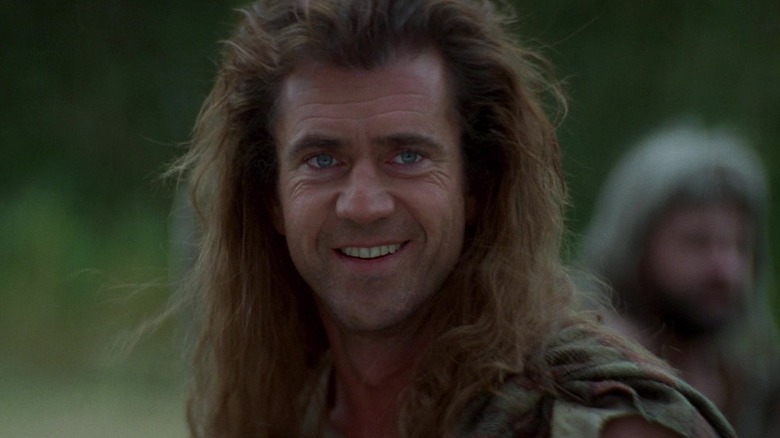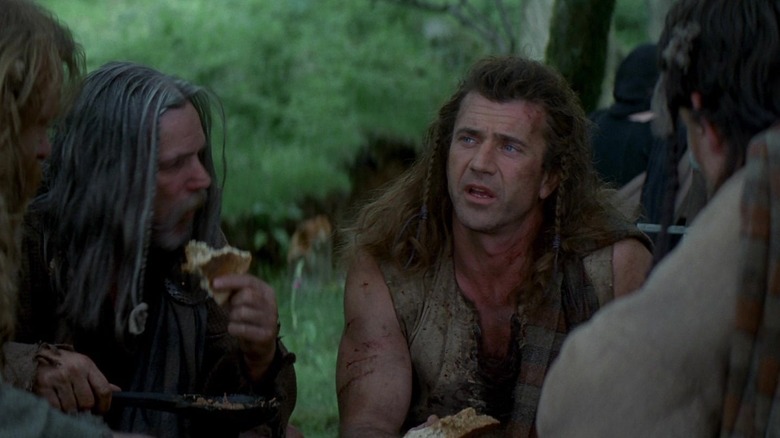Braveheart Facts That Deserve Their Freedom
When Mel Gibson pulled on a kilt, painted his face blue, and picked up the most oversized sword since Excalibur, things could have gotten hysterically bad pretty quickly. Yet, even when he starts strutting around angrily and giving passionate speeches about freedom in a peculiar accent, "Braveheart" just works. Gibson brought depth to his performance as the famous Scottish freedom fighter William Wallace. Despite playing hard and fast with historical facts and leaning into more stereotypes than you can blow a bagpipe at, "Braveheart" has an epic, moving, and soul-stirring quality that makes you want to scream, "You can count on my steel Wallace!"
Almost 30 years later, "Braveheart" still entertains and engages with the full force of a Hollywood blockbuster. In Wallace, you have the eternal, slightly unhinged underdog with a bloodthirsty temper and heart of gold. In King Edward I, you have a brutal overlord who comes out with lines like, "The trouble with Scotland is it's full of Scots." It's pure pantomime, yet it's extremely effective in creating a villain who is pure evil and who must be beaten at any cost.
When you throw in a host of committed performances, some of the finest battle scenes ever committed to film, and the sort of speeches that put fire in your belly, "Braveheart" rises above all its criticisms like a tartan phoenix. Here are some interesting facts about Gibson's period classic.
Braveheart was filmed mainly in Ireland
Since its release in 1995, "Braveheart" has become as Scottish as Haggis in the eyes of the world. It introduced audiences everywhere to the wonderous, mist-covered Scottish Highlands, a place of rugged beauty where paganism once thrived, far from the reach of armies and empires. But, here's the thing: "Braveheart" was filmed mainly on the Emerald Isle, not in Bonnie Scotland. According to Movie Locations, when it was announced that a biopic of one of the most famous sons of Scotland was going to be filmed in Ireland, it was a bone of contention. After all, it's not like Scotland is short of brooding peaks, majestic views, and untamed scenery.
As is so often the case in the film world, the decision to shoot "Braveheart" in Ireland was governed by finances. The Republic of Ireland offers filmmakers the incentive of tax breaks, not to mention allowing its army to be used as extras in battle scenes, a huge bonus for a film like "Braveheart." Scenes set at Edinburgh Castle and the Battle of Falkirk were filmed in Ireland, but the filmmakers knew better than to try and find a substitute for the Scottish Highlands. Mountainous areas that were used in "Highlander" such as Glencoe and Loch Leven were also used to give "Braveheart" an air of authenticity. And, while William Wallace's hometown in the film was built for purpose, it was erected in the valley beneath Scotland's (and Britain's) highest peak, Ben Nevis.
Braveheart's iconic Freedom speech was inspired by Shakespeare
Everyone remembers the iconic freedom speech from "Braveheart" that launched a raft of imitators but has never been topped. When Wallace sits astride a horse and addresses an army of spear-wielding Scots who may be feeling a little apprehensive about a square go with the armored English cavalry, it's rousing stuff. He asks, "Dying in your beds many years from now, would you be willing to trade all the days from this day to that for one chance, just one chance to come back here and tell our enemies that they may take our lives, but they'll never take our freedom!" The answer, of course, is a resounding yes.
Words have the power to move mountains, build worlds, and change the course of history. According to Shakespeare & Beyond, the bard's famous St. Crispin's Day speech from "Henry V" was the influence for Wallace's keynote address in "Braveheart." Like Wallace, Henry has to inspire his men, who are on the eve of facing immeasurable odds at the Battle of Agincourt. "And gentlemen in England, still lying in their beds, will think themselves accursed because they were not here, and be in awe while anyone speaks who fought with us upon Saint Crispin's day," Henry barks. If you swap out England for Scotland, it sounds exactly like something from Wallace's speech.
Sean Connery helped Mel Gibson with his accent
Whether he was playing James Bond or the father of Indiana Jones, Sean Connery never strayed far from the trademark Edinburgh twang that identified him to the world as a proud Scot. Mel Gibson got the chance to pick up some tips from Connery as he tried to perfect the notoriously difficult Scottish accent for "Braveheart." During an interview on The Graham Norton Show, Gibson explained that his first experience with the Scottish accent was tricky. "I was up there and immersed among people who all needed subtitles," he said. In the absence of a professional vocal coach, Gibson revealed he spent time hanging out with Connery to perfect the accent.
"I had dinner with Sean one time and Hungarian goulash was on the menu," Gibson explained (via The Sunday Post). "To hear Sean actually utter a word like 'goulash' is a lesson in itself." Gibson's final accent in the film was dismissed by many as inauthentic, but at least he got a good Sean Connery story out of it. In fact, Connery was almost in the film himself — doing an English accent. According to The Herald, he was approached to play Edward Longshanks in "Braveheart," but he turned it down citing work commitments. Or perhaps the proud Edinburgh lad didn't relish the idea of playing the man known as The Hammer of the Scots.
Braveheart was Robert the Bruce's nickname
The moniker Braveheart is a no-nonsense one. It suggests a person has reservoirs of courage and a cast-iron will. Robert the Bruce may come across as a bit wishy-washy and fearful in "Braveheart," though it was actually he and not William Wallace who earned historic renown under that name.
In the movie, Bruce plays second fiddle to Wallace and is often cast in an unfavorable light. However, it was Bruce's resounding victory over the amassed forces of Edward II at Bannockburn that finally earned Scotland its hard-won independence. According to Smithsonian Magazine, there's no evidence that Bruce "directly betrayed" William Wallace at any point, even if "he did switch sides several times in these early years."
Before the release of "Braveheart," Wallace was known as the knight who won a decisive victory at Stirling Bridge before overplaying his hand at Falkirk. Meanwhile, history tells us that Robert the Bruce inspired his country to finally throw off the shackles of their English oppressors. He was King of Scotland from 1306 to 1329, but his reign wasn't an easy one — in fact, there was only a single year of genuine peace during it. Bruce was named Braveheart posthumously, after a knight loyal to him reportedly carried out his last request.
Bruce apparently asked his friend Sir James "Black" Douglas to take his heart to the Holy Land. Douglas placed the heart in a silver case and set sail, though he decided to drop in on Spain's Alfonso XI on his way. Alfonso was at war with the Moors, and Douglas wanted to help. It's said that he took Bruce's heart into battle with him, throwing it at his enemies while shouting, "Lead on brave heart, I'll follow thee."
Mel Gibson knows his version of Wallace is way off the mark
Giving William Wallace Robert the Bruce's nickname and portraying one of Scotland's national heroes in a less than favorable light was just the tip of the iceberg for "Braveheart." Historians have pointed out that because she wasn't married to the Prince of Wales at the time, Wallace never even met Princess Isabelle, much less made her pregnant. In fact, she didn't marry the prince until three years after Wallace's death. Similarly, kilts are worn throughout the film, despite the fact that they had yet to be invented during Wallace's era. And, in a glaring omission, the Battle of Stirling Bridge doesn't even feature a bridge.
When asked about all the historical inaccuracies in the film, Mel Gibson was defiant. According to the director and star of the picture, filmmakers are always going to exercise their right to artistic licence. "Some people said in telling the story we messed up history," Gibson said (via the Daily Mail). "It doesn't bother me because what I'm giving you is a cinematic experience and I think films are there first to entertain, then teach, then inspire." Gibson admitted that he "romanticized" Wallace to make him "cinematically acceptable," adding that, in reality, he was probably not the nicest of guys. "He always smelled of smoke because he was always burning people's villages down," Gibson said. "He was like what the Vikings called a berserker."
Mel Gibson wanted Jason Patric to play William Wallace
"Braveheart" is very much Mel Gibson's movie. He directed it, he helped produce it, and he stars in it. Among its five Academy Awards are Oscars for best picture and best director. Would the film have been as successful without Gibson in the lead role? Believe it or not, that was almost a reality. Jason Patric, best known for films like "Sleepers" and "The Lost Boys," was actually Gibson's first choice to play the Latin-speaking farmer who leads a national uprising. It's difficult to imagine anyone other than Gibson in the role now, but it's interesting to imagine how things might have played out. But why didn't Gibson want the role for himself from the beginning?
Well, according to Gibson, he initially felt as though he was too old for the part. "Wallace was around 28 when he died and I was already ten years older than that, although at least my knees weren't wrinkly," Gibson said (via the Daily Mail ). It was the studio that insisted on Gibson leading the picture, keen to take advantage of his star power. As for Patric, he explained in an interview with Vulture that he never knew Gibson wanted him to play Wallace until after "Braveheart" was released. "I found out afterwards, so I couldn't really be mad about it," he said. "Wow, that sort of would have been nice. Too bad. I thought it was good, but he was too old for it, which he would admit, too. But, you know, that's the way it goes."
The Gay and Lesbian Alliance slammed the film
Edward II's reputation takes quite a hammering in "Braveheart," portrayed as being weak and spineless. That wouldn't have been an issue had the film not presented these things as a symptom of homosexuality. "Prince Edward is portrayed as a camp stereotype of a gay man, uninterested in his beautiful French wife in favour of a handsome knight the film calls Phillip," reports the website for Newcastle Castle, where Edward II spent a good deal of time during his reign. "In a pretty grisly scene Edward I kills Phillip by throwing him out of a window, which is largely played for a cheap laugh."
San Francisco's Gay and Lesbian Alliance Against Defamation (GLAAD) viewed the film's portrayal of Prince Edward as harmful, particularly the scene in which his partner is murdered so callously. "The Edward II character in Braveheart is a throwback to the classic celluloid queer played for laughs as a simpering weakling," GLAAD's executive director Ellen Carton said at the time (via the Dallas Observer). According to Gibson, Philip's death had nothing to do with his sexuality. "The king didn't throw the character out the window because he's gay," the actor said. "He did it because the king was a psychopath."
Mel Gibson had to prove that no horses were hurt during filming
Everyone familiar with "Braveheart" winces when the Battle of Stirling Bridge approaches, knowing that a bunch of poor horses are about to run into the hidden spears of the canny Scots. Questions about animal welfare got raised in response to the scene, and Gibson had to send footage to an animal rights charity to prove that at no time was the welfare of a horse at risk during the filming of "Braveheart" (via The Times). Film School Rejects reports that the crew of "Braveheart" worked around the clock to ensure that the Battle of Stirling Bridge maintained its air of authenticity, but not at the expense of the horses. The trick was to use mechanical horses for the spear scenes, keeping the real ones far from danger.
When asked about animal welfare on "Braveheart," Gibson said (via News.com) that Ireland — where the Battle of Stirling Bridge was filmed — is "horse country" and there was "a massive racetrack where you could house and stable all your animals" right next to the shoot. Naturally, Gibson was keen to assure anyone who asked (including the Irish Society for Prevention of Cruelty Against Animals) that no horses were harmed during filming. He also went out of his way to make sure no people were hurt. "Before every take, I'd go, 'Remember the S word! What's the S word?' And they'd all go 'Safety!' I said if anybody hurt anyone I'd kill 'em."
The film gave birth to Scotland's Braveheart generation
Many people believe that "Braveheart" changed the narrative on Scottish independence, Mel Gibson included. "Scotland had received partial autonomy, but I think the film started the ball rolling on some stuff," Gibson said (via the Daily Mail). "On the way to the premiere in Scotland the crowd was 50-deep and I couldn't believe there was so much feeling and fervor about the subject." When the film came out, those who campaigned tirelessly for an independent Scotland became known as the "Braveheart" generation. SNP leader Alex Salmon didn't hesitate to use the film's imagery and themes to hit home his political points.
In 2022, Conservative MP Giles Watling accused Gibson of creating division in the United Kingdom. With calls for another independence referendum on the rise in Scotland, Watling brought the subject up with Cabinet Office minister Brendan Clarke-Smith in the House of Commons. "We have fought shoulder to shoulder for freedom and democracy all over the world, not least at Waterloo and the landing beaches of Normandy," he said (via the Scottish Daily Express). "Does he agree it would be foolish to let this great and successful Union fall apart on a whim, with the aid of the likes of Mel Gibson et cetera?"
In a bizarre twist to this tale, actor Angus MacFadyen (who plays Robert the Bruce in "Braveheart") wrote on Twitter in 2022 that he would be willing to "die" fighting the English if they denied them their freedom. "Should Scotland declare itself independent of the UK, and should England decide to reclaim what it considers its rights, and invade our land, I for one would be ready to stand and fight the invading force." Talk about life imitating art.
Braveheart was Randall Wallace's last roll of the dice
"Braveheart" was penned by a then-unknown writer named Randall Wallace. He was just about ready to give up on his dream of becoming a screenwriter when he began working on a William Wallace biopic. "I thought I had one more chance to write a film before I had to go do something hideous, like become a lawyer," he told Forbes on the film's 25th anniversary in 2020. "I wrote the story I wanted to see with complete disregard for whether I thought I could find a market for it. For us, 25 years later, to be discussing why 'Braveheart' is still relevant and exciting to people, is incredible."
By his own admission, Wallace was a "complete unknown" when "Braveheart" got the greenlight. He was delighted when Mel Gibson got involved, and he shared the opinion of the studio when it came to Gibson playing the film's lead character. "Mel was the only actor I could see who could play this role, he was the only one I wanted," Wallace told Forbes. "No-one else fit the bill for me." The writer went on to reveal that he harbored dreams of directing the film himself at one stage, but he was thrilled when Gibson decided to take the reins. He found the Hollywood star to be very down to Earth. "Even with his tremendous experience and industry stature, he listened to me as if I had something to say," Wallace recalled.
Members of the modern Wallace clan appeared as extras
"Braveheart" isn't just a film about William Wallace, it's also something of a family get-together. According to the Daily Mail, Mel Gibson enlisted a little extra help from actual descendants of the man himself. "Braveheart" is positively brimming with the spirit of William Wallace made flesh and blood in the shape of extras who are all part of the Wallace clan. In total, 40 members of the modern-day Wallace clan appear in the battle scenes.
The trouble is, "Braveheart" used around 3,000 extras for its battle scenes, so how do you spot an actual Wallace in the crowd? "If you look for the hardest, scariest dudes on screen, it's those guys," Gibson said. "There was something carnivorous and savage about them." It may sound like a backhanded insult if ever there was one, but News.com reports that Gibson had nothing but admiration for the Wallace clan. The actor praised them for their dedication to traditional Highland ways and their "biting" wit.
Mel Gibson almost got killed during filming
It's no spoiler to say that "Braveheart" doesn't end well for William Wallace. There's no tear-jerking reunion with the love of his life in some remote paradise, no ride into the sunset with his brothers in arms. Just like he was in real life, he's hung, drawn, and quartered in front of a baying mob. Mel Gibson came through the famous scene in one piece, but he did have a close call while filming a battle scene.
"There was a horse that nearly killed me," Gibson told Independent. "He had a good trick where he did this whole rear-up thing, but he'd also fall backwards, which is a problem if you've fallen off fast and you're behind him." The actor went on to reveal that this is exactly what happened to him. Luckily, there was a quick-thinking stuntman on hand to prevent what could have been a tragic turn of events. "My stunt double ran in and pulled me out of the way just as the horse fell."
There were a few other heart-in-mouth moments on the shoot, but everyone came out relatively unscathed. According to Gibson, the only real injuries were "a broken ankle and a hangnail and a busted nose."
A statue of William Wallace carved in the likeness of Mel Gibson has a troubled history
Not long after "Braveheart" was released, a statue of William Wallace carved in the likeness of Mel Gibson was born, and it began a long journey. Per the Independent, the 13-foot sandstone sculpture was created in 1996 by sculptor Tommy Church. It was initially put on display in Church's hometown of Brechin before it was relocated to a more prominent location; the entrance to Stirling's National Wallace Monument. Unfortunately, not everybody liked it. The Scotsman reports that the statue attracted hordes of vandals who doused it in paint and attempted to cut out its face. In 2008, the 12-ton statue was returned to Church's studio. A spokesperson for the Stirling District Tourism Board admitted that "some people liked it while others loathed it."
Church would later donate the statue to Ardrossan, Ayrshire, a place with historic connections to William Wallace. "I couldn't just get rid of it," Church told the Daily Record at the time. "It's the most important piece I have created in my life. It is part of the family." Sadly, the statute wasn't exactly a big hit in Ayrshire, either. In 2021, it was donated again — this time to Brechin City Football Club. "When Tommy came up with the idea we were delighted to accept his offer, which will not only be appreciated by our own supporters but also visiting supporters to the ground," Clark Renilson, the club's community manager, told the Daily Record.
There's an extra hour of Braveheart footage that's never been seen
At just shy of three hours, "Braveheart" is what you'd describe as an epic. These days, it would probably be a sprawling Netflix series instead of a self-contained movie. According to Mel Gibson, "Braveheart" was originally way longer. In a 2016 interview with Collider, Gibson revealed that the original cut of "Braveheart" was three hours and 45 minutes long and that there's an extra hour of footage that has never been seen. Gibson said that if the studio financed it he'd be happy to do a longer cut for general release. "People have mentioned it," he said. "It's a big deal."
Getting from three hours and 45 minutes to the length the studio wanted was no picnic. "I remember bringing it in at three hours and 15 minutes, and thinking we couldn't possibly carve any more out of it, but having to rethink it again," Gibson said (via News.com). He initially resisted executive calls to make the film more compact, but in the end, he realized that they were right. After taking the advice of studio head Sherry Lansing on board, Gibson and editor Steve Rosenbloom were able to "get from three hours and 15 minutes to two hours and 48 minutes, almost half an hour, and then it really sang."
